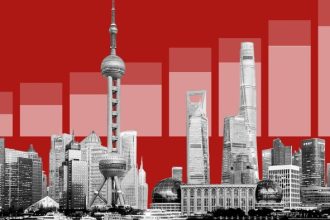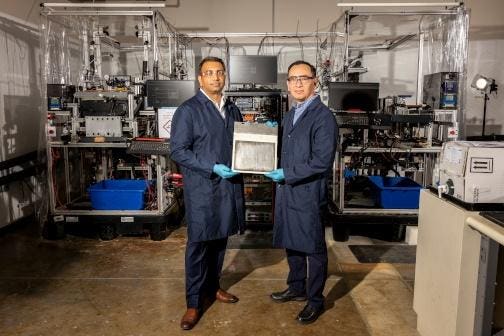Most enterprises run into the ‘Steel Curtain’ when they try to decarbonize steel. But Electra sees a way around the impenetrable fortress — a tribute to the 1970s all-star Pittsburgh Steeler defense. Moreover, it’s a move to revitalize American-made steel; Pittsburgh closed those mills in the 1980s, and 150,000 workers lost jobs.
While visiting the Boulder, Colorado-based outfit, researchers demonstrated its low-carbon method of making purified iron comprising 98% steel. The company is confident it can go bigger now that it has the backing of some brand names.
“Steel is one of the hardest sectors to decarbonize,” Sandeep Nijhawan, chief executive and co-founder of Electra, told me. “There are only three or four ways to get there. It is a hard transition, but that is exactly why we started the business.”
As the world’s economy and population expand, steel demand will also grow — a product used in everything from buildings to bridges to automobiles. The Catch-22: While it is a healthy sign that national economies are expanding, steel production is carbon-intensive.
Electra upgrades low-grade iron using green electricity, resulting in much lower carbon emissions — at least at the pilot scale. The goal is to commercialize the technology by decade’s end, producing 100,000 tons of green iron annually.
Steel is a $1 trillion industry, producing 2 billion tons annually and contributing about 7% of the globe’s greenhouse gas emissions. Demand will jump to 2.5 billion tons yearly by 2050 — tied to economic growth in China and India. The sector aims to reduce emissions by half by 2030 and to hit net zero by 2050.
Electra wants to be a dynasty — backed with $85 million from Nucor
NUE
AMZN
MSFT
Specifically, metallurgical coal and iron oxide produce steel in a so-called blast furnace, which accounts for 70% of all steel made worldwide. Those ovens run at 1,600 degrees Celsius to remove water and other chemicals. Ultimately, it produces a coke — a pure-carbon source that goes into steel.
Can the U.S. be a Net Exporter?
However, Electra uses renewable power to replace coal. While green energy is often the cheapest fuel, it is intermittent and can’t sustain the continuous high temperatures required by blast furnaces.
Electra’s technology operates at about 60 degrees Celsius, making it compatible with intermittent renewable energy. Electra electrochemically refines iron ore into clean iron metal. It will sell that output to operators of electric arc furnaces to process with scrap into steel.
Blast furnaces release between 1.8 and 2.3 tons of CO2 per ton of produced steel, whereas an electric arc furnace emits .5 to 1.1 tons of CO2.
“The steelmakers are looking for higher and higher iron content — with lower impurities to feed into the steel-making process,” says Nijhawan. “We do not give them any impurities, which can be more competitive in the market.”
Electra operates between the mine site and the steel mill. Australia, Brazil, and India are significant iron-ore producers. While the world is flush with iron ore, there will be a shortage of high-quality ore by 2030 — ore with an iron content of 65% or greater. However, Electra uses low-grade ore discarded during mining, employing a wasted resource and possibly avoiding more excavation.
With its low-cost renewable energy and the world’s largest fleet of electric furnaces, the United States can produce green steel. Moreover, major semiconductor, automotive, wind, and solar equipment factories are located here.
“The U.S. can be a net exporter,” says Nijhawan. “We have the feedstock and technology, making it the logical place to make steel. We dilute the impurities in the scrap and make green iron without CO2.”
Electra’s founder and chief technology officer, Quoc Pham, led me on a tour of the lab. Scientists and engineers schooled me on how they transform the rock that emerges from the ground into steel: they turn low-grade ore into a liquid — a process that purifies it. An electric current is then passed through the liquid, extracting the pure iron and turning it into a solid.
Can Electra Get in the End Zone?
In principle, Electra can use any ore. Its interest, though, is using low-grade iron ore, which excavators with sensors can parse through and separate. Its staff can upgrade the waste to make high-quality iron. But that process takes energy and creates more waste — a resource that Electra consigns to secondary markets.
The goal is to scale up — to produce more extensive iron plates. The engineering behind it is critical to getting there.
“Our goal is to have a product at price parity versus how we make steel today,” says CEO Nijhawan. “However, if more carbon-conscious companies want green steel, the price goes up. The awareness and the demand for that product are high while the supply side is constrained.”
It requires a holistic view — from mining the ore to shipping it to steel mills. Indeed, it takes teamwork, ranging from the entrepreneurs to the manufacturers to the policymakers.
The technology is the initial hurdle. But access to green electricity is paramount and prices must continue to fall. Then there’s a question of logistics — getting the ore and sending it to the steel mill, where it will be transformed and upgraded. And finally, steelmakers must dispose of the waste.
Take Nucor, which uses electric arc furnaces and scraps to make low-emissions steel: Electra will provide pure iron as a feedstock — blended with recycled material — to make steel. The technology dilutes the impurities in the scrap. The steelmaker is investing in Appalachian states like Kentucky and West Virginia.
It is constructing a $2.7 billion steel mill in the latter — one that will run on green power. American Electric
AEP
GM
As expected, Nucor’s investment in coal country is giving the region new life. But its purpose is even greater. Suppose this idea works as planned: It will revolutionize steel-making, re-shoring a staple of the American economy and, perhaps, returning to Pittsburgh, now a high-tech hub.
“We believe we have a path, but it is not easy,” says co-founder Pham. “It will be bumpy, with challenges and problems. But my philosophy is to build the best team to scale up and make this happen. We are not denying there will be obstacles, although people will find a way around the walls.”
Decarbonizing steel is a monumental task. But Electra intends to circumvent the barriers — potentially providing a massive bonus for the global economy and the Paris climate accord.
Read the full article here





